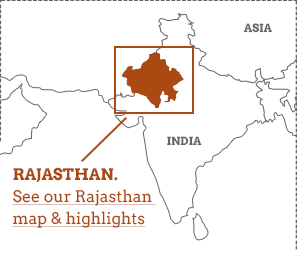A brief history of Rajasthan
We travel to Rajasthan for history, and boy, do we get history. About 5,000 years of it, in fact, with Rajasthan relishing its heritage that has seen the ancient Maurya Empire, Rajput clans taking control as early as 700 AD, Mughals stepping in around 1200 AD until their decline in the 18th century, when the Maratha Empire made its mark. It is a complex state, with empires and epics that were lived out in the desert and mountains, leaving palaces and temples which we fawn over today as tourists. Below we skirt over the basics like a trailer for the full Bollywood movie which is, in fact, more like a 20-series box set than a one off tale.
Read more It is really the medieval period of history onwards, around the 8th century that we come across most on our travels around Rajasthan when the Rajput clan maintained power against forces coming from all sides. Up until the 12th century the clan was divided into 36 royal clans and 21 dynasties and the extraordinary forts and palaces of Rajasthan are right royal remnants of this era. A period when Rajasthan was actually known as Rajputana, Rajasthani for “Land of the Rajputs” which, at the time, included present day Rajasthan but also parts of Madhya Pradesh, Gujarat and some areas of modern day Pakistan. The state was not named Rajasthan until British colonial times.
The main force to contend with for the Rajputs were the Mughals, Muslim raiders and rulers who started to move into northern India at the beginning of the 8th century, creating the stunning Middle Eastern architectural influence that we still see there today. The modern day language of Urdu (or Hindustani) originates from this period and about 8.5 percent of Rajasthani people are Muslim today. The Rajputs managed to keep the Mughal forces at bay, however, in contrast with other areas of India. This strong sense of independence is still felt in Rajasthan, with its living culture of literature, art, cuisine and music, all still flying the Rajput flag which began during this golden age emanating from the Rajput-Mughal struggles. Forts that were built as part of this struggle include Ranthambore Fort in the eponymous national park, Amber and Jaigarh Forts in Jaipur, Chittaurgarh Fort in Udaipur and of course the daddy of them all in terms of architectural beauty and location, location, location, Jaisalmer Fort in the Thar Desert.
Although many Rajput kings were totally against Islamic rule in Rajasthan, some decided to merge forces, particularly after the defeat of the Rajput Chauhan clan in 1200. One of the major Mughal leaders at this time was Akbar, who was emperor from 1556 until his death in 1605. He made his first big mark on Rajasthan at Chittorgarh Fort, just over 100km from Udaipur and the town of which, Chittor, he made capital having finally seized that from Rajput prince, Raja Uday Singh of Mewar who had founded the city of Udaipur. His capital was eventually moved to Udaipur and remained so until 1818, when it became a British princely state. During Akbar’s rule, and the resistance fought by various Raj princes, it was not uncommon for women loyal to Rajputs to commit mass suicides rather than succumb to Mughal power. They would carry out mass self-immolations, known jauhar. Indeed, Chittorgarh still hosts the biggest Rajput festival, Jauhar Mela. It takes place annually, in February or March, on the anniversary of Rani Padmini's jauhar, and commemorates all three jauhars that took place here. There are processions and remembrance events attended by a huge number of Rajputs which include the descendants of most of the princely. families.
The Hindu Maratha Empire finally ended Mughal rule in India during the Mughal–Maratha Wars of 1680 to 1707 led by Shivaji. The Marathas stayed in power throughout India until they were defeated in the Second Anglo-Maratha War which left the East India Company in control of most of India. Evidence of this wealthy empire is best seen in the magnificent havelis or mansion houses, many of which were built between 1830-1930 when wealthy Marwaris created these elegant homes, bedecked with hand painted murals and boasting two inner courtyards, one for men and one for women. Many can still be seen in the Shekhavati region.
British control of Rajasthan worked under the name Rajputana Agency, in the region then to be named Rajputana Province and, finally, in 1949, Rajasthan when the 19 Rajput states signed a treaty to become so. However, several autonomous ‘princely states’ were also agreed, including Jaipur and Jodhpur, which is why you can still find incredible palaces, boasting wealthy princely heritage in many of them. It is worth noting that the glorious art collections in these palaces, not known to many tourists, are often accessible, and bring it home just how wealthy these places were at one point in history.
Post independence from British colonial rule in 1947, Rajasthan went through various stages of geographical fluidity, with Udaipur joining the state in 1948. Jaipur and the desert kingdoms of Bikaner, Jodhpur and Jaisalmer retained independence, however, until March 1949. At this time, the Maharaja of Jaipur, Man Singh II was made the Rajpramukh of the state and Jaipur became capital of Rajasthan, now the largest state in India. Independence from Raj royalty didn’t come cheap, however, as princes of former kingdoms were handsomely recompensed for handing over their rule, with payments known as privy purses. These were abolished in 1971 by Prime Minister Indira Gandhi. Today, on your travels, you will notice that many of the former princes still use the title of Maharaja, which continues to hold great sway in terms of status and financial power. Many have created elegant and high end hotels out of their palaces and lands.





























